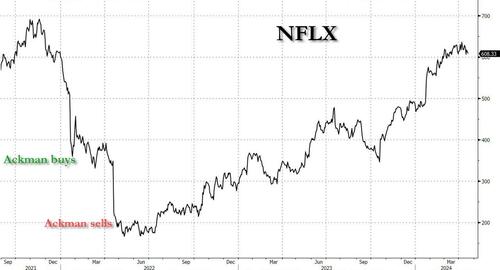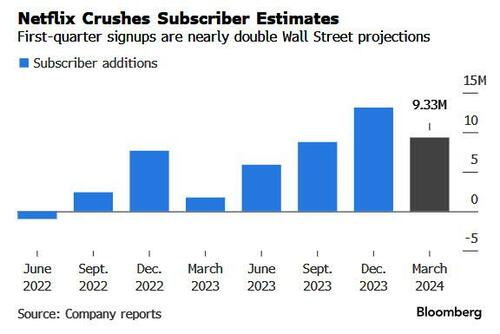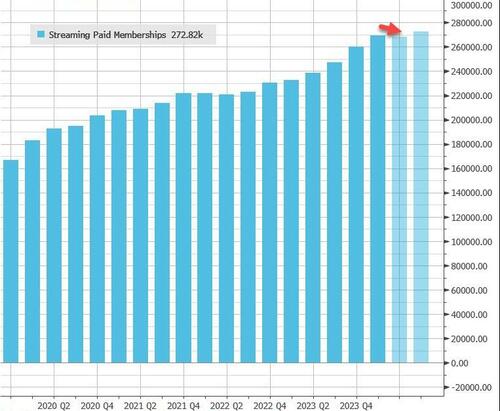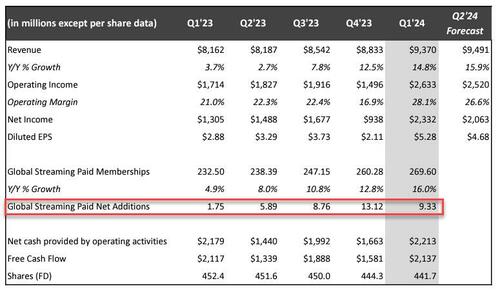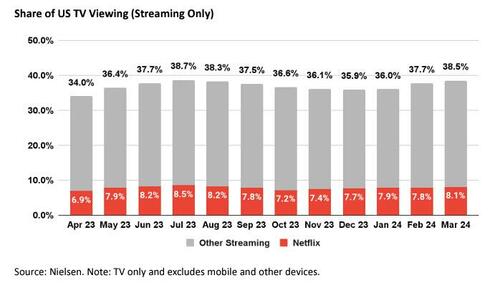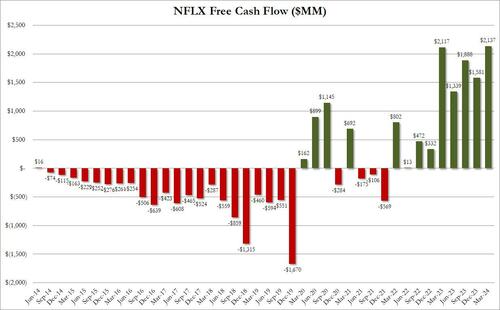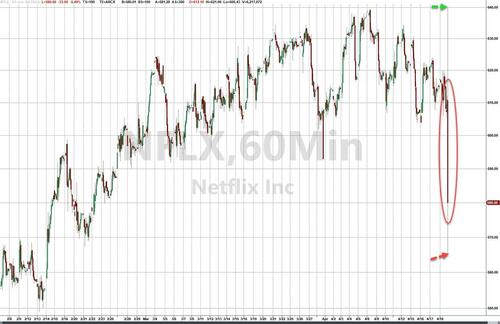Netflix Reports Blowout Q1 Results & Sub Adds, But Warns Gains Will Slow, Will End Reporting Of Quarterly Subs; Stock Slides
After suffering a historic collapse at the end of 2021, when in the span of five months Netflix lost 75% of its value, and when Ackman first bought then immediately dump the stock just around the generational bottom, the company has enjoyed a stellar recovery over the past two year when it rose by nearly 300%, from a low of $166 to a recent high of price of $636, just shy of the record hit in late 2021.
It is therefore not surprising that after this tremendous ascent and nearly 3x return, that both Goldman and UBS agree that Netflix remains a very crowded long with investors very bullish. According to UBS, “the bull thesis continues to revolve around the residual impact of password sharing and they are just scratching the surface on the scale of the ads business” while “the rationalization of content spend and direct-to-consumer efforts from competitors will also be a tailwind for Netflix.” Goldman chimes in that positioning and sentiment skew more long – as NFLX’s multiple is approaching multi-year highs – with stock up ~28% YTD and short interest back at 10 year lows.
That said, UBS cautions that stretched positioning and the stock near $620 cause some to pause, but given they are the first one out of the gate, the stock could benefit from investors using it as a safety play.
On the earnings print, investors will be focused on:
- magnitude of upside to sub net adds
- pricing updates as estimates are underpinned by price increases eventually hitting;
- tailwinds from paid sharing and if there are legs left versus already in run rate;
- updates on scaling in ad business progress into 2H/2025, and consistent message on revenue re-acceleration;
- updates to margin expectations (~2-3pts y/y annual OM expansion) and spending plans given pullback at peers; and
- updates on live content/sports strategy.
And here are the main bogeys:
- Q1 Subscriber Adds: 8MM (heard a wide range of estimate – some higher, up to 10MM, some lower, 7-8MM, Goldman expects +7MM)
- Q1 Revenue Growth adjusted for FX: +16-17%
- Q1 Reported Revenue Growth: +14%
- Q1 EBIT: $2.4B, +40% y/y
- Q2 Subscriber Adds: 4M
- Q2 Revenue Growth adjusted for FX: +17%
- Q2 Reported Revenue Growth: +16%
- Q2 EBIT: $2.4BN
- FY24 Operating Margin: reiterate guide at 24%
- FY24 FCF Guide: $6BN
With that in mind, and considering that options are pricing in a roughly 7% swing after hours today, here is what NFLX reported for its first quarter:
- EPS $5.28, beating the estimate $4.52, and more than double the $2.88
- Revenue $9.37 billion, up a whopping 15% y/y, and beating the estimate $9.26 billion
- Revenue was above the company’s guidance as paid net additions (9.3M vs. 1.8M in Q1’23) were higher than we forecast.
- Streaming paid net change +9.33 million smashed estimates of 4.84 million, were just shy of the highest whisper number of 10 million and were far above the +1.75 million subs added a year ago. This was the best start of the year since 2020!
- UCAN streaming paid net change +2.53 million vs. +100,000 y/y, beating estimates of +988,580
- EMEA streaming paid net change +2.92 million vs. +640,000 y/y, beating estimates of +1.58 million
- LATAM streaming paid net change +1.72 million vs. -450,000 y/y, beating estimates of +837,467
- APAC streaming paid net change +2.16 million, +48% y/y, beating estimates of +1.48 million
- Operating margin 28.1% vs. 21% y/y, estimate 25.7%
- Operating income $2.63 billion, a whopping +54% increase y/y, and beat estimates of $2.43 billion
- Free cash flow $2.14 billion, +0.9% y/y, and also beat estimate $1.87 billion
Bottom line: Q1 subscriber adds smashed estimates in what was the best Q1 for NFLX since 2020 when the pandemic led to an unprecedented growth surge.
Netflix ended Q1 with total streaming paid memberships of 269.6 million, up 16% y/y, and well above the estimate of 264.52 million. The subs are in line with what it guided last quarter when it said that “paid net additions to be down sequentially but to be up versus Q1’23 paid net adds of 1.8M.”
About 40% of Netflix’s new customers are selecting the advertising option in markets where it’s available, the company said. The advertising tier is still minuscule relative to online video giants like YouTube.
Netflix has successfully rebounded from a post-covid slowdown in 2021 and 2022 to grow at its fastest rate since the early days of the coronavirus pandemic. That is due largely to its crackdown on people who were using someone else’s account. The company estimated more than 100 million people were using an account for which they didn’t pay. While executives at Netflix feared a backlash from customers, the company has been able to convince millions of moochers to pay for access.
Looking ahead, for Q2 Netflix sees the following:
- Revenue $9.49 billion, missing the estimate $9.51 billion
- EPS $4.68, beating the estimate $4.54
- Operating margin 26.6%, beating estimate 25.4%
Drilling down into the Q2 forecast reveals:
- revenue growth of 16% which equates to 21% growth on a F/X neutral basis due primarily to price changes in Argentina and the devaluation of the local currency relative to the US dollar.
- paid net additions should be lower in Q2’24 vs. Q1’24 due to typical seasonality
- the company also forecasts global ARM to be up year-over-year on a F/X neutral basis in Q2. This is what the quarterly subs look like historically and vs WS estimates:
For the full year, NFLX sees revenue growth between 13% and 15%, boosted its operating margin outlook to 25%, beating the estimate of 24.1%, and above the 24% expected previously; the company still sees free cash flow about $6 billion, estimate $6.49 billion
And here are the results and projections summarized:
And here is the regional detail: for the third consecutive quarter, EMEA (Europe, the Middle East and Africa) accounted for the largest share of Netflix’s growth in the quarter. The company added almost 3 million customers in that region, following the 5 million added last quarter. The average amount Netflix makes per customer has increased only modestly in the past year, at $16.64, and rising 3%.
Yet despite the blowout numbers this quarter, something bad may be on deck because NFLX reported that starting next year with 1Q 2025 earnings, the company will stop reporting quarterly membership numbers and ARM; to counter that, the company will also start providing annual revenue outlook. Here is the explanation, straight from the quarterly report:
As we’ve noted in previous letters, we’re focused on revenue and operating margin as our primary financial metrics — and engagement (i.e. time spent) as our best proxy for customer satisfaction. In our early days, when we had little revenue or profit, membership growth was a strong indicator of our future potential. But now we’re generating very substantial profit and free cash flow (FCF). We are also developing new revenue streams like advertising and our extra member feature, so memberships are just one component of our growth. In addition, as we’ve evolved our pricing and plans from a single to multiple tiers with different price points depending on the country, each incremental paid membership has a very different business impact. It’s why we stopped providing quarterly paid membership guidance in 2023 and, starting next year with our Q1’25 earnings, we will stop reporting quarterly membership numbers and ARM.
We’ll continue to provide a breakout of revenue by region each quarter and the F/X impact to complement our financials. For guidance, we’ll add annual revenue guidance on top of what we already provide today: our annual operating margin and free cash flow forecast and forecasts for quarterly revenue, operating income, net income, and EPS. We’ll also announce major subscriber milestones as we cross them.
Instead of subs, NFLX – like Musk – plans on providing more details on overall engagement: “we’ve been providing progressively more information on engagement, starting with our Top 10 weekly and most popular lists and more recently our bi-annual report into viewing on Netflix (which covers ~99% of all video watch time on our service). This is more information than any of our competitors provide, and we expect to provide even more over time.”
Netflix finished the quarter with gross debt of $14B and cash and cash equivalents of $7B; curiously, it boosted the revolving credit facility to $3 billion from $1 billion. NFLX expects to refinance its upcoming debt maturities and we don’t currently have plans to lever up to buy back stock as we value balance sheet flexibility
Expectations for Netflix’s first quarter had soared in recent days, as one analyst after another published rosy forecasts. Pouring some cold water on expectations, NFLX said subscriber gains will be lower this period, even as revenue will increase 16%, or more than expected.
Netflix also said it will stop reporting paid quarterly membership and revenue per subscriber, starting with the first quarter of 2025. Those metrics have long been the primary way Wall Street evaluated the company’s performance, but Netflix has tried to shift the focus to traditional measures like sales and profit. Management will continue to report major subscriber milestones.
“The movement to no longer disclose quarterly subscriptions from next year will not go down well,” Paolo Pescatore, founder and analyst at PP Foresight, said in an email. “More so given the subscriber growth that the streaming king has seen over the last year.”
To be sure, new customers have had plenty to watch. Netflix has delivered a new hit every couple weeks so far this year, including limited series such as Fool Me Once and Griselda, the dramas The Gentleman and 3 Body Problem and the reality show Love Is Blind. The streaming service accounts for 8.1% of TV viewing in the US, and is a leading TV network in most of the world’s major media markets.
“With more than two people per household on average, we have an audience of over half a billion people,” the company said in its letter. “No entertainment company has ever programmed at this scale and with this ambition before.”
Yet even skeptical analysts have been impressed with the company’s recent performance, lifting their price targets for investors. To sustain its growth going forward, Netflix has also introduced a cheaper, advertising-supported version of its service targeting cost-conscious customers. It’s also begun to invest in live programming, including stand-up specials, wrestling and an upcoming boxing match.
Turning to the once-problematic cash flow statement, the company generated cash from operating activities of $2.2B in Q1, and free cash flow of $2.1B (both flat with Q1’23).
During the quarter, NFLX paid down $400M of senior notes with cash on hand and repurchased 3.6M shares for $2B. The company finished the quarter with gross debt of $14B and cash and cash equivalents of $7B.
NFLX is still forecasting full year 2024 free cash flow of approximately $6B and cash content spend of up to $17B.
Finally, here is the explanation for why NFLX is boosting its revolver:
We’re modestly evolving our capital allocation strategy to better reflect our investment grade status. Going forward, rather than anchoring to $10-$15B of gross debt and minimum cash equivalent to two months of revenue, we’ll maintain financial policies consistent with a solid investment grade credit rating. In particular, we’ll continue to prioritize profitable growth by reinvesting in our business, maintain a healthy balance sheet and ample liquidity, and return excess cash (beyond several billion dollars of minimum cash and any used for selective M&A) to shareholders through share repurchases.
As part of this evolution, we’ve upsized our revolving credit facility from $1B to $3B. This will bolster our access to liquidity, and enable us to improve our cash efficiency, over time. We also expect to refinance our upcoming debt maturities and we don’t currently have plans to lever up to buy back stock as we value balance sheet flexibility
The recent growth lifted Netflix shares back toward record highs, giving the company a market value of more than $260 billion. It set an all-time closing high of $691.69 in November 2021, although today’s earnings will likely slow down the recent gains: while the result were solid, and the beat was across the board, the stock initially spiked then, and at last check NFLX was down about $20 from its closing price of $610, and about $100 below its record high from Nov 2021.
Tyler Durden
Thu, 04/18/2024 – 16:36
via ZeroHedge News https://ift.tt/GIWbhas Tyler Durden
